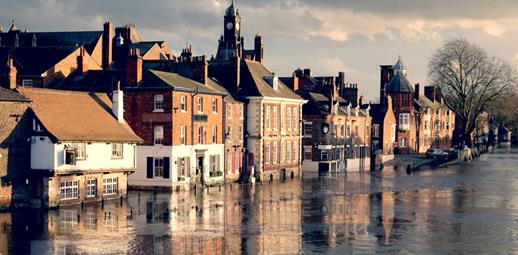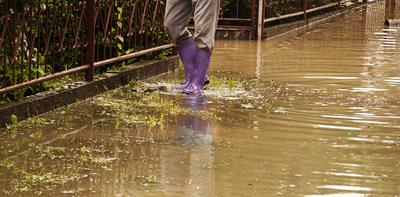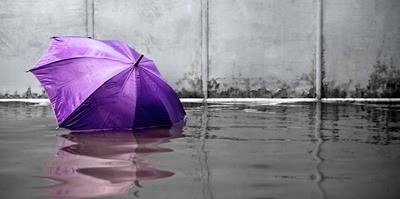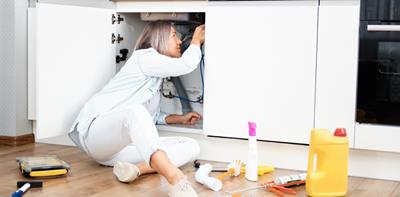
Flooding can occur with little to no warning and have a devestating impact. Climate change is making the problem worse: in England alone, the new National Flood Rise Assessment (NaFRA) has found that around 6.3 million homes and businesses are at risk of flooding.[1]
But according to the National Preparedness Commission, only 2 in 5 people [2] believe their local community is prepared for a flood. So, now is the time to find out the extent of the flood risk in your area, and then take steps to protect your home.
EASY AS HACK
Sign up to free flood alerts for your area so you can take action as quickly as possible.
At a glance
Help protect your home from floods
- Prep a flood kit just in case
- Contact your insurer immediately after a flood
how to flood proof your home
There are many ways you can flood proof your home. Some are quick fixes that will help during a flash flood. Some will take longer to implement but will help protect you if you live in a flood risk area.
quick flood proofing measures
If you’re caught unawares by a flood, here are some things you can do to reduce the damage:
- Prevent water infiltrating into your house: while sandbags have been traditionally used a cheap flood barrier, a test conducted at an accredited British Standard Institute test tank found that they were not very effective. Use tape, sheeting, boards and ballast instead. If you don’t have access to these, you can roll towels up and push them under door frames to slow the flow of water. You’ll need to throw them away afterwards.
- Move household appliances: if you can, unplug and move household appliances to higher ground. Do the same with your valuables.
- Move your car: Move your car to higher ground if you can, to prevent it being swept away. If you have a garage, park your car in there.
- Cover the vents: Cover air vents with thick plastic or other waterproof material to prevent flood water from entering your home.
- Drape your curtains: Tuck your curtains over their poles to stop them from getting wet.
long term flood proofing measures
If you live in a flood-prone area, it’s a good idea to look at using some long-term flood proof measures. These are some things you can do to minimise the risk of flooding:
- Seal your walls: depending on the type of external walls you have and the age of your property, this can be achieved through various methods like applying waterproof coatings, using membranes or installing damp-proof courses.
- Landscape your garden to divert water
- Maintain your gutters: keep your gutters clear of debris and make sure all your downspouts are free flowing
- Plant trees and shrubs: Tree roots slow down the flow of water
- Move your sockets: move your sockets higher up on the walls to minimise the chance of water damage
- Update your skirting boards: replace the wooden ones with something non-perishable, like plastic
- Fit non-return valves: this will stop water coming up through your drains
- Ensure proper grading: grading levels, or reshapes, the ground around your house to direct water away from the foundations
- Get flood gates: Flood gates go across your doorways and other entrances to prevent flooding and can be removed after a flood
- Install porous paving, gravel: Porous paving and gravel will help water drain away faster, preventing flooding.
- Flood door: A flood door is a permanent installation and works in the same way a flood gate does.
- Flood-proof flooring: Use a waterproof material, like vinyl, for your flooring to prevent water from seeping through.
- Fit high shelving: Put shelving high up so you have somewhere safe to store your valuables if your house does flood.
- Get air brick covers: If you have air bricks, you can invest in some air brick covers. They create a watertight seal and prevent water from flowing through your air bricks.
how to prepare for a flood
- If you live in a flood risk area, you should sign up for free flood alerts. These will be sent via text or email when it’s suspected there could be flooding.
- You can sign up online at the following sites:
- England (flood warnings)
- Scotland (flood warnings)
- Wales (flood warnings)
- In Northern Ireland, flood warnings are available from the Met Office
- Check your home insurance and make sure you have cover for flood damage. If you haven’t, see if you can add it. It's a good idea to take a moment to review how 'flood' is defined in your policy wording, including what's covered and what's not. This helps ensure your coverage matches your needs.
- Create an emergency supply kit in a waterproof bag including:
- Bottled water and food
- Blankets
- A torch and spare batteries
- Essential medicines
- Supplies for looking after your baby or pet (including toys)
- Rubber gloves and wellington boots
- You should keep your insurance policy documents and contact details for your insurer, local council and utility providers in this kit as well.
What to do if your home floods
If your home floods, what’s most important is your safety. Find your flood kit, and turn off your mains water, gas, and electricity if it’s safe to do so. You should avoid touching the flood water as it could be contaminated by sewage and may be fast flowing.
You should always evacuate if told to do so.
What should you do after a flood
First, contact your insurer so they know you’ve been flooded, and you can start the process of claiming.
Avoid touching your electrics until a professional has told you it’s safe. Even if you think the water hasn’t damaged your electrics, it’s better to be on the safe side.
Check your tap water. If it has changed colour, smell, or taste do not use it. You should call a professional to sort the problem out.
Throw away any food that has been touched by the flood water as well as any food from the fridge if the electricity has been off for more than four hours, and the freezer if it’s been longer than 24 hours.
how to clean up after a flood
Before starting to clean up, contact your insurer for advice on what to do and what they can cover (cleaning, replacing items etc). Take photos of any damage as this will help with your insurance claim.
Get rid of any items that have been contaminated by flood water.
Open all the windows to create airflow and begin the drying process. You can use fans to promote air circulation and dehumidifiers to remove excess water from the air. If necessary, use industrial heaters to dry out your walls.
While you may want to clean your house yourself after a flood, it’s a good idea to get a professional cleaning company in as they’ll have all the necessary equipment – the cost may also be covered by your insurance.
does my house insurance cover flooding?
You’ll need to check your home insurance policy to find out if it covers flooding.
how to find out if your property is at risk of flooding
Depending on where you live, you can use the following websites to check the flood risk in your area:
FAQs
how to prevent your basement flooding
To prevent your basement from flooding, seal the walls, any window wells and the foundation. You can also install a sump pump, which will remove any water that gets into your basement. You may want to put any valuables high up, so they are out of range of any flood water.
how to prevent your garage flooding
To prevent your garage flooding, seal the doors and any windows. You can also use flood bags or sandbags to absorb any water that does make it in.
how to prevent your garden flooding
It’s possible to landscape your garden so that it will divert any surface water away from your property. You can also prevent flooding by maintaining your gutters and drainage systems and planting the right types of plants and trees. You can also consider rainwater harvesting as a means of preventing flooding
Sources
[1] - gov.uk/government/publications/national-assessment-of-flood-and-coastal-erosion-risk-in-england-2024
[2] - nationalpreparednesscommission.uk


